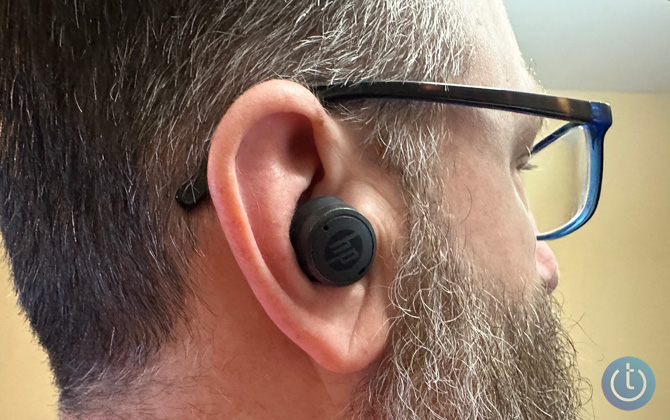There have been only around a dozen self-fitting over-the-counter hearing aids (OTC HA) introduced into the market since the new FDA OTC hearing aid regulations went into effect last fall. These new self-fitting OTC HAs are designed to help compensate for the mild to moderate hearing loss suffered by an estimated 35-plus million people in the U.S. and to approximate the performance of prescription hearing aids you’d buy from an audiologist – but at a much lower cost. OTC HAs remove the audiologist middle person, which means instead of paying $4,000-$8,000 for prescription hearing aids, self-fitting OTC HAs sell for less than $3,000, usually between $400-$1,300, depending on make and model.

Despite the thus far limited selection of less expensive self-fitting OTC HAs, it is quite easy to find a model that fits your hearing improvement needs, lifestyle, and budget. Having said that, we have it on good authority that a second wave of OTC hearing aids with more features and possibly lower price points than this first wave is due in the fall.
Whether you want to buy now or decide to wait until more models are available and, hopefully, prices fall even further, you need to identify not only the right OTC HA for you but what terms like “self-fitting” and “FDA cleared” mean to understand what you’re getting – and what you’re not.
You’ll also want to determine whether you want to wear a hearing aid all day long or only when you need it and if private music listening is as important to you – if not more so – as improved hearing.
But first, you want to understand OTC HA labeling and what the varying terms mean that vendors splash on their packaging, websites, and advertising. Unfortunately, the FDA has essentially abdicated policing and enforcement of misleading or false OTC HA packaging and marketing claims, which means you have to interpret claims you read – or know when essential information is missing. We'll help you to do that.
OTC Hearing Aid terms you should know
To get an OTC HA hearing aid that most closely approximates what you’d get from an audiologist, here’s what to look for:
Self-Fitting
Self-fitting is defined by the FDA as “a wearable sound amplifying device that is intended to compensate for impaired hearing and incorporates technology, including software, that allows users to program their hearing aids.”
In practical terms, a self-fitting OTC HA’s smartphone app includes a self-administered hearing test. While in a quiet room and wearing the hearing aids, you’ll be asked whether or not you can hear certain tones at different frequencies (high-end treble to low-end bass) at different volume levels for each ear. The app then programs the resulting hearing profile into the buds to correct for your specific hearing loss, similar to how prescription eyeglasses correct your specific vision issues. Once the buds are programmed, you’ll be able to hear missing frequencies, and what you can normally hear will be cleaned and cleared up as well as amplified.
Hearing aids that are NOT self-fitting often include “presets” – essentially preset frequency/volume settings to compensate for differences in varying acoustic environments such as meetings, restaurants, or TV. These presets merely amplify what you already hear while compensating for environmental conditions. They do not increase or add frequencies you cannot normally hear, nor do they clean up what you can normally hear. Non-self-fitting hearing aids are akin to magnifying glasses that merely enlarge what you see without correcting for presbyopia, near or far-sightedness. You will often see them referred to as personal sound amplification products (PSAPs).
Some non-self-fitting OCT HA apps include a hearing test, but the results are essentially for your information only. The buds aren’t subsequently programmed with the results to compensate for your hearing deficiencies.
Since they involve a lot more technology, self-fitting OTC HAs are at least twice as expensive as non-self-fitting models.
FDA “Cleared” vs. “Approved”
Beware of OTC HAs that claim they are FDA “approved.” The FDA does not “approve” OTC HAs, which implies a federal government quality imprimatur. The FDA only “certifies” or “clears” (or “clearance”) OTC hearing aids, which means devices simply comply with the agency’s OTC HA technical specifications and regulations after certified testing. If you see an OTC HA that proclaims it is FDA “approved,” that’s not a thing and should spark concern.
All FDA-cleared OTC hearing aids, however, do qualify as Class II medical devices.
FDA Regulatory Codes
There are specific, often confusing and unnecessarily complicated, codes for FDA OTC HA certification that vendors often include – or, suspiciously, do not – on their packaging, marketing, or sales material.
The most important code is QUH (regulatory number 874.3325), which the FDA defines as a “Self-Fitting Air-Conduction Hearing Aid.” If you want the closest approximation to an audiologist-prescribed hearing aid, you want a self-fitting device that carries the QUH 874.3325 designation.
You may see two other “Q” non-self-fitting, non-corrective OTC HA codes: QUG (regulatory number 874.3305), which the FDA describes as “Hearing Aid, Air-Conduction With Wireless Technology” – essentially a PSAP, and QUF (regulatory number 874.3300), which describes a familiar behind-the-ear style, aka RIC (Receiver In the Canal), hearing aid. Neither of these codes, however, defines a self-fitting corrective OTC HA.
You also might see the designations 501(k) or 501(k) (Exempt). Even folks within the OTC HA industry find this term and its regulatory definition confusing. Technically, the FDA defines a device as “exempt” “if the FDA determines that a 510(k) is not required to provide reasonable assurance of safety and effectiveness for the device.” In practical terms for OTC HA shopping, “exempt” may mean a company’s self-testing for efficacy may not be as complete or trustworthy as that of non-exempt models.
The two types of OTC Hearing Aids
Two types of self-fitting OTC HAs have emerged. The first are OTC HAs designed to be worn all day and do little other than boost your hearing. These all-day OTC HAs are exemplified by the Eargo 7 ($2,950) and its previous models line, the Sony CRE-C10 ($999.99), and the Lexie B2 powered by Bose ($999). The second type of OTC HAs are newer Bluetooth-enabled earbuds that combine hearing correction and wireless stereo music listening.
All-day OTC Hearing Aids
All-day OTC HAs& are essentially no-frill devices – if they do include Bluetooth, it’s for hands-free phone calls only and decidedly not for wireless music listening – with day-long battery life. They are designed to perform a single function – boost your hearing.
All-day OTC HAs are also tiny and meant to disappear in your ears. Since few folks like to admit to or physically exhibit any signs of aging, all-day OTC HAs are designed so other people won’t know you’re wearing them.
Functionally, all-day OTC HAs are built with so-called “open” designs. An open design means ambient noise can enter your ears and mix with the buds’ own corrected and amplified sound. The aural effect on your hearing of self-fitting open hearing aids seems almost magical. Volume and conversation comprehension is suddenly transformed back to what you remember as normal hearing, with all sounds, including your own voice, sounding completely natural. Self-fitting OTC HAs require a few days for your brain to adapt to the new and improved aural inputs it receives. With hearing loss, your brain has essentially forgotten what true sound sounds like and needs to reorient itself.
You also can don a pair of over-the-ear headphones over tiny all-day OTC HAs (wearing headphones over behind-the-ear RIC models can be uncomfortable) to hear your music and phone calls with the same heightened clarity, fidelity, and amplification as everyday sounds and voices.
Bluetooth-bud OTC Hearing Aids
Bluetooth-bud OTC HAs such as the HP Hearing Pro “powered” (made) by Nuheara ($699), the Jabra Enhance Plus ($799), and the Sony CRE-E10 ($1,299.99), look and act just like their non-hearing aid versions, and often include the same features. Unlike all-day models, though, Bluetooth bud OTC HAs are highly visible – many folks will think you’re rude for wearing them when talking to them and think you’re not really listening to them, especially in business situations.
While not necessarily uncomfortable, you really don’t want to wear Bluetooth bud OTC HAs for more than a few hours at a stretch – your ears will breathe a sigh of relief when you finally remove them. In most cases, not only won’t you want to wear Bluetooth bud OTC HAs for more than a few hours at a time, you won’t be able to. Like their non-hearing-aids siblings, Bluetooth-bud OTC HAs battery life is usually limited to 5-7 hours, shorter if you use them primarily for music listening. The one exception to this battery limitation is the Sony CRE-E10, which boast a 26-hour continuous use battery life – but at the expense of the quality of music playback and the consistency of the Bluetooth wireless connection.
Like most Bluetooth earbuds, Bluetooth bud OTC HAs are “closed” – their silicon or foam tips are designed to seal your ear canal. This is a good thing for music listening since a sealed canal means you get maximum music fidelity – none of the music is leaking out or diluted by ambient sound.
For hearing the regular world, however, a sealed canal is not a good thing. Without the mix of ambient and amplified sounds provided by open hearing aids, you are entirely dependent on the bud microphones to feed to sounds of people and your environment into your ears. As a result, not only doesn’t the world sound quite as natural or “normal” as it will with open hearing aids, but your own voice will be muffled. As anyone who is hard of hearing knows, if you can’t hear yourself, you end up talking too loud to the point that other people think that YOU’RE SHOUTING AT THEM, a tendency exacerbated by Bluetooth bud OTC HAs.
As a result, Bluetooth-bud OTC HAs should be considered only if you need or want occasional hearing help. Many of us with mild or moderate hearing loss have gotten used to a muffled environment and don’t mind not being constantly bombarded by the loud and noisy world.
So which of today’s current OTC HAs is the right choice for your specific auditory and lifestyle needs? Check out our Techlicious Top Picks for the best OTC Hearing Aids to see our latest recommendations.
[Image credit: Stewart Wolpin/Techlicious]
Stewart Wolpin has been writing about consumer electronics for more than 35 years, including news, reviews, analysis and history, and has attended and covered nearly 50 Consumer Electronic Shows and around a dozen IFA shows in Berlin. For the Consumer Technology Association (CTA), he is an elector for and writes the official biographies of the annual CT Hall of Fame inductees, and is the keeper of the industry’s official history.














